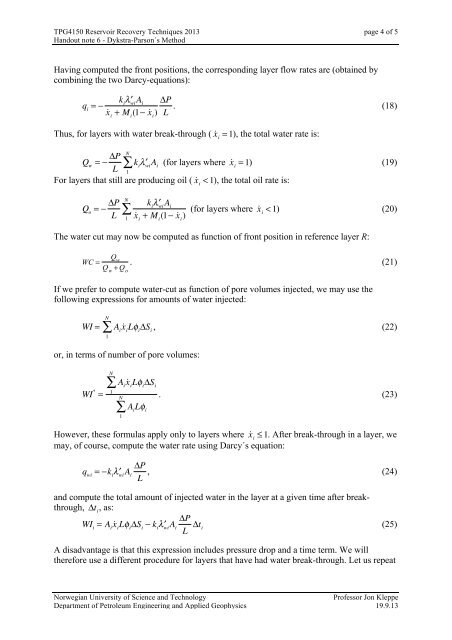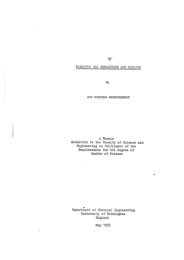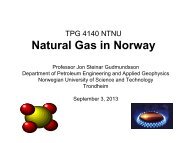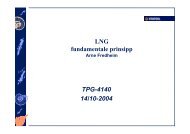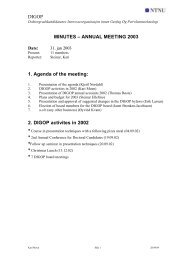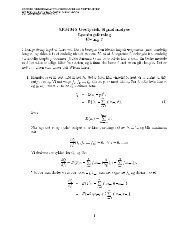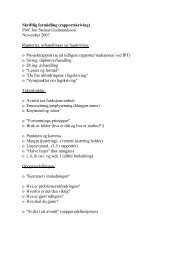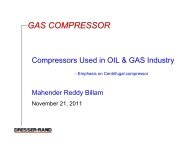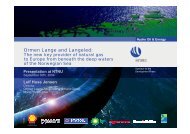Dykstra-Parson's Method for Isolated Layers
Dykstra-Parson's Method for Isolated Layers
Dykstra-Parson's Method for Isolated Layers
You also want an ePaper? Increase the reach of your titles
YUMPU automatically turns print PDFs into web optimized ePapers that Google loves.
TPG4150 Reservoir Recovery Techniques 2013<br />
Handout note 6 - <strong>Dykstra</strong>-Parson´s <strong>Method</strong><br />
page 4 of 5<br />
Having computed the front positions, the corresponding layer flow rates are (obtained by<br />
combining the two Darcy-equations):<br />
k<br />
q i<br />
= − i<br />
λ wi<br />
′ A i<br />
x ˙ i<br />
+ M i<br />
(1− x ˙ i<br />
)<br />
ΔP<br />
L . (18)<br />
Thus, <strong>for</strong> layers with water break-through ( x ˙ i<br />
= 1), the total water rate is:<br />
N<br />
Q w<br />
= − ΔP ∑ k<br />
L<br />
λ i<br />
′ A (<strong>for</strong> layers where x ˙<br />
wi i<br />
i<br />
= 1) (19)<br />
1<br />
For layers that still are producing oil ( x ˙ i<br />
< 1), the total oil rate is:<br />
Q o<br />
= − ΔP L<br />
N<br />
k i<br />
λ wi<br />
′ A<br />
∑<br />
i<br />
(<strong>for</strong> layers where x ˙<br />
x ˙ i<br />
+ M i<br />
(1− x ˙ i<br />
)<br />
i<br />
< 1) (20)<br />
1<br />
The water cut may now be computed as function of front position in reference layer R:<br />
WC =<br />
Q w<br />
Q w<br />
+ Q o<br />
. (21)<br />
If we prefer to compute water-cut as function of pore volumes injected, we may use the<br />
following expressions <strong>for</strong> amounts of water injected:<br />
N<br />
WI = ∑ A x i ˙ Lφ ΔS , (22)<br />
i i i<br />
1<br />
or, in terms of number of pore volumes:<br />
WI * =<br />
N<br />
∑<br />
1<br />
A i<br />
x ˙ i<br />
Lφ i<br />
ΔS i<br />
N<br />
∑<br />
1<br />
A i<br />
Lφ i<br />
. (23)<br />
However, these <strong>for</strong>mulas apply only to layers where x ˙ i<br />
≤ 1. After break-through in a layer, we<br />
may, of course, compute the water rate using Darcy´s equation:<br />
ΔP<br />
q wi<br />
= −k i<br />
λ wi<br />
′ A i<br />
L , (24)<br />
and compute the total amount of injected water in the layer at a given time after breakthrough,<br />
Δt i<br />
, as:<br />
ΔP<br />
WI i<br />
= A i<br />
x ˙ i<br />
Lφ i<br />
ΔS i<br />
− k i<br />
λ wi<br />
′ A i<br />
L Δt (25)<br />
i<br />
A disadvantage is that this expression includes pressure drop and a time term. We will<br />
there<strong>for</strong>e use a different procedure <strong>for</strong> layers that have had water break-through. Let us repeat<br />
Norwegian University of Science and Technology<br />
Professor Jon Kleppe<br />
Department of Petroleum Engineering and Applied Geophysics 19.9.13


